
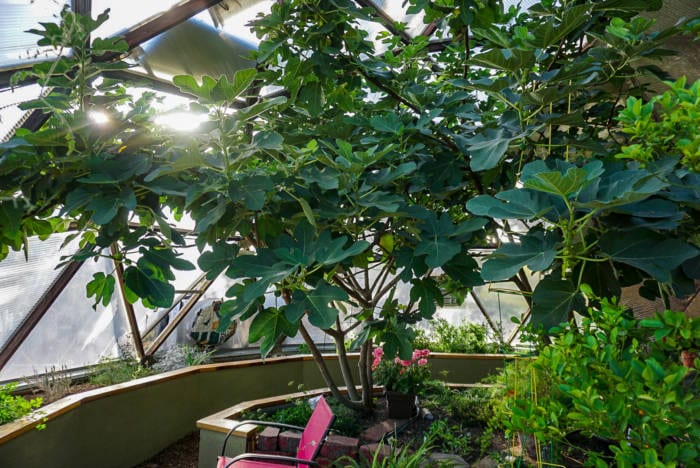
The Best Fruit Tree to Grow in a Greenhouse
Fig trees are one of the best ways to achieve summer shade and stabilized temperatures in your Growing Dome Greenhouse. They are forgiving in depleted dry soil conditions, extreme heat or cold, and inadequate ventilation conditions. Fig trees are relatively disease and pest-resistant. They produce broad leaves at the perfect time in the spring to provide natural shade for your plants and lose them just in time for fall when you need more sun. Figs thrive in full sun and make delicious fruit. It is hard to imagine a better fruit tree for dome greenhouse growing.
Fig Trees: Planting, Growing, Pruning, and Harvesting

Choosing the Right Type of Figs for Your Greenhouse
There are several varieties of figs to choose from, and they are all suitable for growing in dome greenhouses. The fig trees at our Growing Domes in Pagosa Springs are Mission, Kadota, and Smith.
If you live in zones 2-4, the Hardy Chicago Fig might be best as it has evolved to handle below-freezing winter weather. It is a great option for anyone who is looking for a real winter hardy fruit tree. All the other fig varieties are also cold hardy but will suffer if they hard freeze for a long period of time.
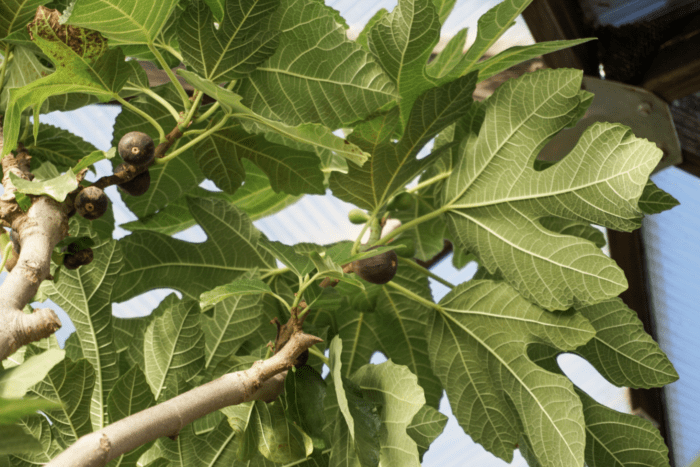
If your fig tree freezes, then you can cut back the dead growth in the spring, so that it can regrow from the base. Also, adding large rocks, gravel, or river rocks around the tree roots will increase its thermal mass. Doing this will help safeguard your fig roots if your Grow Dome hard freezes for an extended period of time.
Those in zone 6 and up can enjoy any fig tree. Just remember to properly prune it from the start because it will grow like a weed in your environment.
When & Where to Plant a Fig Tree in Your Dome Greenhouse
The best time of year to plant your fig trees is early spring while the sapling is still dormant. However, figs will also thrive if planted in the summer or fall. In cold climates, it is better if a fig sapling is in the ground for winter, as opposed to in a pot.
The best place to plant fig trees is in the center raised beds to ensure plenty of space for root/top growth and optimal shading capability.
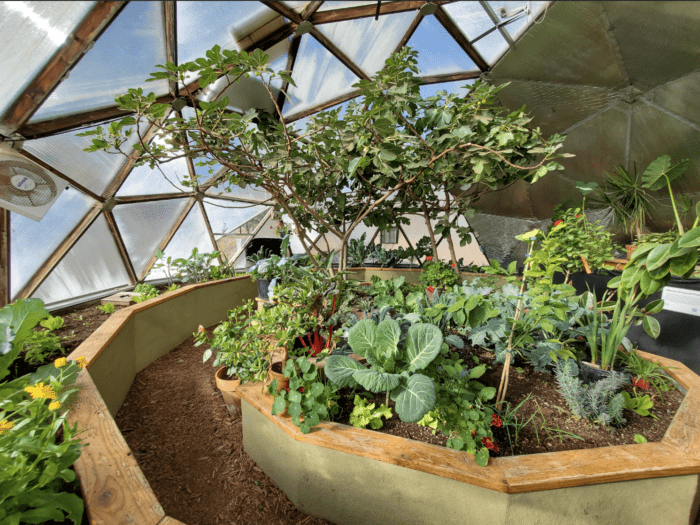
Proper Fig Tree Maintenance
Watering
It is essential to keep your fig tree well watered in the spring, particularly when they are budding out and fruiting. We recommend using the soil “touch test” for when to water.
Later in the year, closer to summer, when fruit starts ripening, cut back on watering so that the sugar in the figs can condense. This will make them ripen better and have extra flavor. The only exception would be if the tree is still very young and its root structure is shallow. When the tree is young, more care will be needed in regular watering. When your tree matures and is more established, you can safely pull back on water when the fruit is ripening.
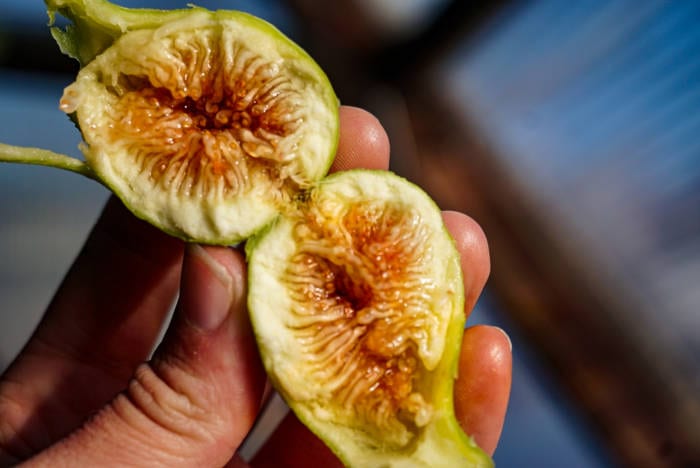
Figs do not need quite as much water when they are dormant in the winter. Still, the soil needs water to remain healthy, so periodic watering is necessary. The frequency will depend on your conditions so check the soil every one or two weeks for needs.
Fertilizing
Figs rarely need fertilizing and when they do, they will let you know by the color of their leaves, lack of fruit production and ripening, and presence of suckers or disease. Be careful when fertilizing, as you can over-fertilize a fig tree, which will result in a lack of fruiting or fruit ripening and various other issues of imbalance.
Fortunately, you can troubleshoot most issues with an easy internet search. For example, you might search for something like “Yellowing fig leaves.” Some causes for yellow leaves are nitrogen deficiency, potassium deficiency, over or under-watering, and insect infestations.
In my case, last year, the deficiency was nitrogen, and I used plenty of fish emulsion to remedy the issue. I applied the fish emulsion weekly and watched the new leaf growth until it became a darker, brighter green and looked healthy. The tree produced the most fruit it ever has and ripened beautifully through mid-fall. This would not have been the case if I had over-fertilized.
The application of a probiotic and mycorrhiza formula is always supportive in making nutrients more available and supporting the tree’s general health. I like to do this for my entire garden in the spring and then again regularly later in the summer when trees and vegetables are laden with ripening fruit.
EXPERT TIP: Sometimes, I will fertilize with a balanced NPK fertilizer if an older tree is holding a lot of fruit, once or twice as support. This can strengthen the tree, so it is less likely to be compromised by disease or weakness.
Pruning
As I mentioned earlier, figs are very forgiving. This also applies to their hardiness regarding pruning. This is a tree you are unlikely to hurt if it is established.
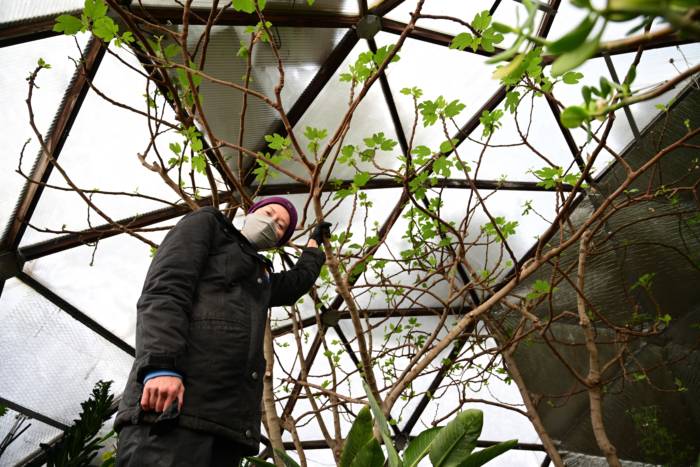
We prune figs to take some burden off of the root structure and support optimal fruit production while increasing overall resiliency. Trimming your tree will also promote better air movement and light penetration, which supports the tree’s health while also improving fruit quality. It is hard to believe but pruning your fig tree is one of the kindest things you could do for it.
It is best to trim trees when they have gone dormant. This is in winter after they have lost all their leaves and the sap of the tree is mostly in its roots. During this time, the tree is not growing and is in a kind of deep hibernation.
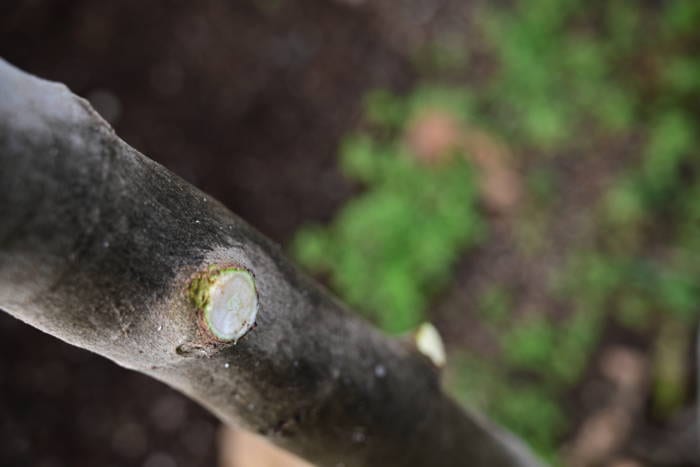
Cutting branches when dormant will produce far less milk or sap at the cut points and will protect the tree from losing life force. We recommend that you wear gloves when pruning in case any milk or sap touches your skin, as it can cause irritation.
Start with sharp, clean clippers or loppers.
Focus on suckers coming up from the ground. Remove them all as they steal energy from the mother tree. Suckers are an indication that this tree is stressed. This could be from nutrient deficiencies, improper water, poor soil, or because it is root-bound.
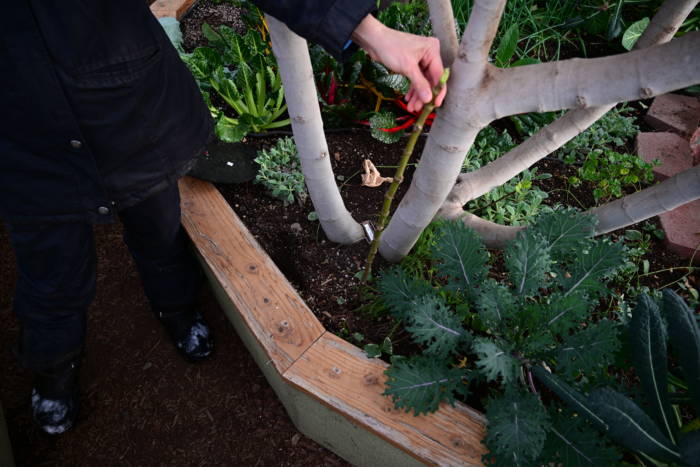

Next, focus on dead or diseased branches. Take the whole branch down to the joining segment.
Focus on cutting the tree back from the outer walls of your dome. When the tree leaves are out, those leaves should not be touching the hot and wet walls of your greenhouse. This will contribute to disease in the fig tree and systemically in your whole dome. This is part of the effort to minimize fungal infections and decomposing plant material to safeguard your gardens for years to come.
You will cut these the same way you cut dead or diseased branches by cutting down to the first or second link. The focus here is on consolidating energy to the tree’s primary branches and allowing light into the fruit-bearing area so that the fruit will ripen properly and have optimal flavor.
This will involve thinning smaller branches nearer to the tree’s core or thinning branches growing too close to the main branches. The intention is to prevent branches from touching and leaning on each other. These branches will not get optimal ventilation or light to produce great fruit and a brilliantly healthy tree.
The general rule with fruit trees is one can safely prune 1/3 of the top of the tree. I use this as my general guideline with figs though they are far hardier than your average fruit tree and can tolerate more when absolutely needed. Pruning 1/3, or less for tiny trees, is a good goal to support the tree’s health.
Treating Bound Roots & Poor Soil Health
It is ideal to prevent future bound roots by first putting your fig in a raised bed that is deep and wide enough to accommodate it 20+ years down the road. One of our fig trees in Pagosa Springs is 24 years old, which is as old as the Dome itself. Will the fig tree outlive our Growing Dome? Hard to say, we have Growing Domes throughout the country that are well over 30 years old.
The key point is always to remember to plan ahead when planting a fig tree as it will take up a lot of space. And if needed, prune heavily. Pruning is one of the primary solutions to support root-bound trees along with proper watering.
If your fig tree is root bound and has poor water drainage, it might get root rot. Watering needs are different in every situation and various kinds of soil. If this happens, please call Growing Spaces for help with this or any other gardening questions.
In an instance where your fig is quite old and quite giant like ours, you may also experience poor soil health. Unfortunately, this cannot be fixed traditionally.
My solution is always to increase the life in that soil and do my best to make it as viable as possible with regular watering and supplements. Probiotic and mycorrhiza formulas are indispensable tools for bringing old, dying earth back to life. They can be bought at hydroponic supply, garden supply, or online stores. Compost teas, live whey, manure teas, and any fermented fertilizers are also valuable.
There are many options, and I prefer to use a variety to repopulate the soil with a diverse colony of microorganisms that will thrive in the future, as long as I keep it watered.
Harvesting Figs
Figs generally ripen early to mid-summer. This may vary depending on your growing zone. They are ready to harvest when the fruit is soft. Most often the color changes and there is also a little bead of milk at the open bottom end of the fruit (the eye).
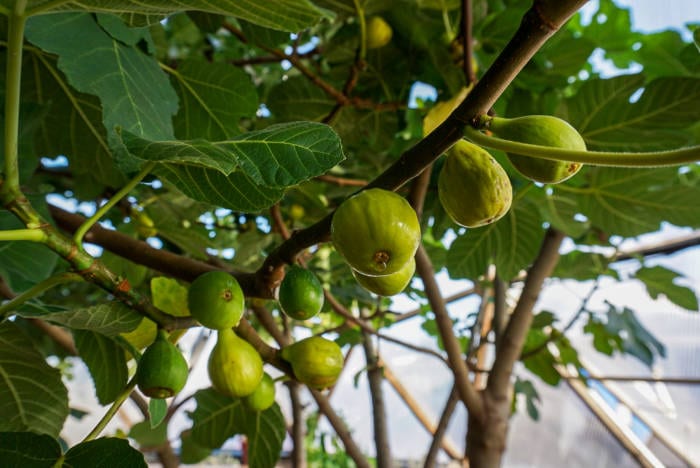
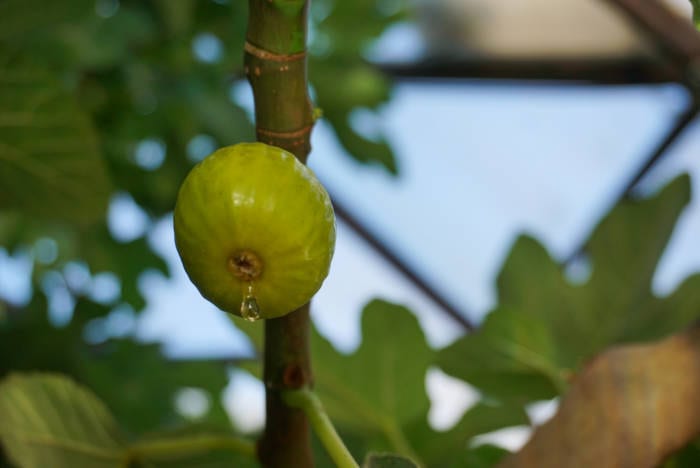
Whether you have an ancient fig tree like ours or are planting a fig tree in your Growing Dome for the very first time, we hope this article provided you with some valuable information about growing a fig tree in your greenhouse.

2 Comments
This is a great article on growing figs in the dome. It answered a lot of my questions. Articles on growing citrus, avocados, grapes, etc. will be greatly appreciated.
Cathy, I have positive hands-on experience with the following citrus trees in greenhouse cultivation: Improved Meyer Lemon, Key Lime and Calamondin. All these will remain small enough for container culture and produce fruit if you’ll use a paint brush or can find pollinators to do this for you. Meyer lemon can take light frost, the others may need to be brought indoors if your Grow Dome cannot conveniently be kept above freezing.